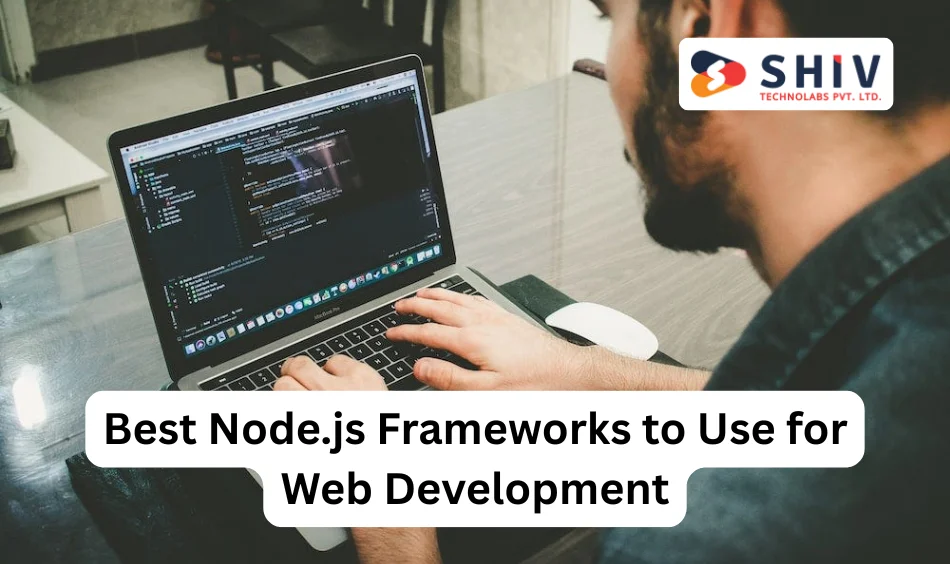Table of Contents
Node.js remains a trusted choice for backend development in 2025. Developers prefer it for its speed, flexibility, and strong community support. Still, selecting the right framework matters as much as picking the platform itself. Today’s options offer various Node.js web application frameworks, each with a specific focus. Some are built for speed, others for structure or large-scale systems.
This post outlines the top Node.js frameworks for web apps, helping developers and teams choose tools that match their project needs. Whether you’re building a real-time system or a secure backend, this list can guide you toward a better approach.
Role of Node.js Frameworks in Backend Development
Node.js frameworks help developers work faster and keep backend code organized. Instead of starting from scratch, developers rely on these tools to manage routing, middleware, API connections, security, and data handling.
Each framework offers different structures and features. Some focus on speed, while others support complex app logic or real-time updates. Whether you’re working on a small project or a large platform, the right framework saves time and reduces complexity.
In 2025, frameworks such as Express, NestJS, and Fastify continue to be popular choices due to their unique features, performance, and support for growing needs.
Also Read: Node JS Development: A Complete Guide {2025}
Best Node.js Frameworks to Use for Web Development in 2025

When creating modern web applications, the right backend tool can shape your results. In 2025, Node.js for web development is still a popular choice because of its speed, flexibility, and JavaScript-based approach. But its true value lies in the tools built around it. Below is a closer look at the top Node.js frameworks for web apps, each offering a different way to solve real-world problems.
1. Express.js Framework
Express.js continues to lead as one of the most popular Node.js frameworks in 2025. It keeps things simple, which makes it a go-to tool for both beginners and experienced teams. Express acts as a thin layer on top of Node.js and gives you full control over the app structure.
Key Features
- Lightweight and unopinionated
- Supports a wide range of middleware
- Massive community and ecosystem
It’s widely used in Node.js for web development, powering projects ranging from single-page apps to large-scale platforms. If you’re looking for a fast setup and full flexibility, Express is still one of the best Node.js frameworks out there.
2. NestJS Framework
NestJS has seen rapid adoption among enterprise developers. Built with TypeScript, it provides a modular and scalable structure. If your project needs clean architecture and strong typing, NestJS is a smart option.
Key Features
- Uses decorators for routing and logic separation
- Built-in support for GraphQL and microservices
- Encourages organized code and solid patterns
NestJS has become one of the top Node.js frameworks for complex applications. It’s also a favorite in Node.js for backend development, especially in finance, healthcare, and SaaS platforms. For those seeking a full-featured setup, NestJS offers a strong balance of power and structure.
3. Fastify
Fastify has earned attention for one reason: speed. It was designed to be faster than Express, and many tests show it meets that goal. The framework also supports plugins, schema validation, and detailed logging, all with low overhead.
Key Advantages
- Built-in logging and input validation
- JSON Schema support
- Works well under heavy load
In 2025, Fastify ranks among the best Node.js frameworks for projects that need quick response times and efficient memory use. It’s often used in Node.js backend frameworks where performance is a top concern.
4. Koa.js
Created by the same team behind Express, Koa.js offers a lightweight and modern alternative. It uses async/await functions out of the box, giving developers a cleaner way to handle asynchronous logic.
Benefits of Koa
- Minimal core with no bundled middleware
- High control over request handling
- Clean and expressive syntax
Koa has gained traction in Node.js frameworks 2025 lists for its flexibility and small footprint. Developers who prefer to build their stack from the ground up often pick Koa. It’s suitable for projects that demand a fine-grained control approach.
5. Hapi.js
Hapi.js stands out for its strong focus on configuration, security, and API management. It doesn’t depend heavily on external libraries, giving you a tightly controlled environment.
Why developers choose the Hapi.js Framework
- Built-in input validation
- Caching and authentication tools
- Plugin-based system
In the world of Node.js web application frameworks, Hapi is widely used in large-scale enterprise apps and public-facing APIs. Companies needing strict control over data flow and user access often prefer it.
6. Sails.js
Sails.js uses an MVC architecture inspired by frameworks like Ruby on Rails. It fits well with real-time features, especially when working with WebSockets. It also supports data-driven applications by offering built-in tools for database interaction.
Why Sails.js Gets Chosen
- Built-in support for WebSockets and RESTful APIs
- Follows the familiar MVC pattern
- Works well with databases using its Waterline ORM
Sails.js stands out in Node.js for web development, where teams need features like real-time updates and user management. It fits projects like chat apps, live dashboards, or booking systems. Among the top Node.js frameworks, Sails continues to serve teams that want less boilerplate with more built-in options.
7. AdonisJS
AdonisJS brings structure and predictability to development. It borrows many ideas from Laravel (PHP) and focuses on developer experience. Written in TypeScript, it includes out-of-the-box support for routing, validation, authentication, and ORM.
What Makes AdonisJS Stand Out
- Pre-built tools for everyday backend tasks
- Consistent folder structure
- TypeScript-first design
Many developers consider it the best Node.js framework for the backend if they want built-in support without adding too many external tools. Adonis fits businesses that require rapid development cycles but don’t want to compromise on code quality.
8. Meteor.js
Meteor.js offers a full-stack environment using JavaScript from client to server. It has built-in support for real-time data updates, making it a strong choice for interactive apps. In 2025, it remains useful for quick MVPs and apps that need real-time data sync.
Key Highlights
- Works end-to-end with JavaScript
- Real-time data handling through WebSockets
- Tight integration with MongoDB
While it’s not as widely used as it once was, Meteor remains on the list of most popular Node.js frameworks in 2025 for fast prototyping. If your focus is quick delivery and live features, Meteor might still be the right choice.
9. Feathers.js
Feathers.js is a service-based framework that works well for REST and real-time applications. It’s built on top of Express and adds layers to simplify the development of APIs. You can connect it with databases, authentication tools, and frontend frameworks easily.
Features Developers Appreciate
- Easy to set up REST and WebSocket APIs
- Works with both SQL and NoSQL databases
- Modular structure for better control
Feathers ranks high among Node.js backend frameworks thanks to its focus on flexibility and speed. It supports microservices and works well in systems that use separate services for users, notifications, and chat.
10. Total.js
Total.js offers a complete environment with features like CMS, real-time processing, and API handling. It doesn’t rely heavily on external tools. The framework provides built-in features for routing, templating, and database management.
Why Total.js is Gaining Attention
- Rich built-in modules
- Supports dashboards, IoT, and eCommerce apps
- Suitable for full-stack development
In 2025, Total.js is seen as one of the top Node.js frameworks for web apps with broader requirements. If you need a full system that doesn’t require much external setup, this framework delivers that experience.
Also Read: Top 12 Best JavaScript Frameworks You Must Know 2025
# Quick Comparison of Node.js Frameworks
Choosing the right framework can save time and simplify your development process. This comparison highlights the key strengths, features, and ideal use cases of the top Node.js frameworks in 2025, helping you decide what fits best for your web project.
| Framework | Core Focus | Key Features | Best For |
|---|---|---|---|
| Express.js | Simplicity & Flexibility | Lightweight, middleware-based, minimal setup | RESTful APIs, SPAs, microservices |
| NestJS | Scalable Architecture | TypeScript support, dependency injection, GraphQL, modular design | Enterprise apps, scalable backend systems |
| Fastify | Speed & Performance | Low overhead, async-first, schema validation, efficient plugins | High-performance APIs, microservices |
| Koa.js | Custom Web Stack | Async/await out-of-the-box, lightweight core, no bundled middleware | APIs with custom architecture |
| Hapi.js | Security & Configuration | Built-in validation, caching, plugin system, configuration-first | Secure, large-scale apps with detailed settings |
| AdonisJS | Full-Stack Structure | MVC, ORM, authentication modules, TypeScript | Business apps, structured backend development |
| Sails.js | Real-Time & Data APIs | Auto-generated REST, WebSockets, Waterline ORM | Real-time dashboards, chat apps |
| Meteor.js | Full-Stack Real-Time | Real-time sync, isomorphic JS, web + mobile support | MVPs, prototypes, and real-time collaboration tools |
| Feathers.js | Lightweight Service APIs | REST & WebSocket APIs, modular design, works with SQL/NoSQL | Microservices, real-time apps, lightweight API development |
| Total.js | Feature-Rich All-in-One | CMS, WebSocket, eCommerce modules, MVC support | Complex web solutions, dashboards, multi-feature platforms |
How to Choose the Right Node.js Framework for Your Project

With so many Node.js frameworks available in 2025, picking the right one depends on your project’s size, goals, and team preferences. Some frameworks work better for APIs, while others support large-scale enterprise systems or real-time apps. This section will help you narrow down your options based on practical needs, not trends.
Choosing the right tool depends on your project’s scope and technical needs. Here are simple questions to guide the decision:
- Is speed a top concern? → Go with Fastify
- Need built-in structure and tools? → Try NestJS or AdonisJS
- Want flexibility and minimal setup? → Consider Express or Koa
- Building real-time apps? → Look at Sails.js, Meteor, or Feathers.js
- Need full-stack capabilities with fewer tools? → Check Total.js
When selecting from the best Node.js frameworks, match your choice to your development team’s strengths and your long-term goals.
Build Smarter Web Apps with Node.js Experts at Shiv Technolabs
Choosing the right framework is only one step toward building a successful web application. Turning that decision into a working, dependable product takes planning, skill, and real-world experience.
At Shiv Technolabs, NodeJS Development Company, we create fast and reliable web solutions by picking the right Node.js framework for each project. Whether you’re starting fresh or improving an existing system, our team builds backend systems aligned with your business needs.
We focus on Node.js for backend development, helping businesses build web apps that are secure, fast, and designed to grow with time. Whether you need a simple API, a real-time app, or a full web platform, we suggest the right Node.js framework based on your specific goal.
We’ve worked with startups, enterprises, and agencies to build scalable systems using Express, NestJS, Fastify, and more. From planning and architecture to deployment and maintenance, we support the full development cycle.
Final Thoughts
In 2025, developers will have many options when working with Node.js for backend development. Some frameworks let you build quickly, while others support complex systems. Whether you’re working on a basic MVP, a detailed dashboard, or a secure API-focused setup, there’s a Node.js framework that suits the task.
If you’re looking for support choosing the right path or building your idea into a finished product, Shiv Technolabs is ready to assist. We build stable, fast applications using tools that match your project. Want to get started on a custom Node.js app? Get in touch with us to start building smarter with Node.js.























